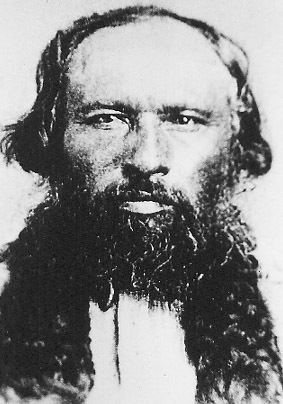Full Name Gabriel Dumont Name Gabriel Dumont | Nationality Metis Role Political leader | |
 | ||
Born December 1, 1837 ( 1837-12-01 ) Known for being a founder of Metis recognition Died May 19, 1906, St. Isidore-de-Bellevue, Saskatchewan, Canada Similar People Louis Riel, Frederick Dobson Middleton, Big Bear, Leif Newry Fitzroy Crozier, Wandering Spirit | ||
Gabriel Dumont (December 1837 – May 19, 1906) was a leader of the Metis people of what is now Western Canada. In 1873 Dumont was elected to the presidency of the short-lived republic of St. Laurent; afterward he continued to play a leading role among the Metis of the South Saskatchewan River. He played a critical role in bringing Louis Riel back to Canada, in order to pressure the Canadian authorities to pay attention to the troubles of the Metis people. He was adjutant general in the provisional Metis government declared in the District of Saskatchewan in 1885, and commanded the Metis forces in the North-West Rebellion or North West Resistance of 1885.
Contents

Early life
Dumont was a grandson of the French Canadian Jean-Baptiste Dumont and his Sarcee-Crow wife, Josette. He was the second son of Isidore Dumont and Louise Laframboise. The family were at various times involved in farming, trading, hunting, and trapping in what is now the province of Saskatchewan. Gabriel was raised a Metis, learning both French Catholic and Cree customs. By the time he was 12, he was considered an accomplished shot with both gun and bow, and was well known as a master horseman. In 1848, the Dumont family moved south to the area where Regina, Saskatchewan, would later be founded. Dumont, and his older brother Isidore, became buffalo hunters. Over time, Dumont learned six languages, and established a reputation as a guide, hunter and interpreter. He was also famed for his drinking and gambling. Dumont participated in skirmishes with First Nations, including the Blackfoot and Sioux.
Dumont married Madeleine Wilkie, the daughter of the Anglo-Metis chief, Jean Baptiste Wilkie, in 1858, and in 1862 was elected chief of his Metis band. He led the band to the North Saskatchewan River, where they briefly settled near Fort Carlton. By 1868, the band established a permanent settlement near Batoche on the South Saskatchewan River. In 1872 Gabriel established a ferry service near Batoche, at "Gabriel's Crossing" (east of present-day Rosthern, Saskatchewan, where the Gabriel Bridge is today) and also farmed near there.
Rebellion
Dumont's enemies in 1885, including General Frederick Middleton of the Northwest Field Force, praised his generalship and martial abilities. Despite huge logistic and morale problems, he can be credited with a victory at the Battle of Fish Creek and managed to hold off a much larger force at the Battle of Batoche for several days. Riel refused to let him make vital strategic actions such as damaging railway lines to hinder the enemy's movement, providing the Canadian government with an advantage.
Following the defeat at Batoche, Dumont made his way via the Cypress Hills to the Montana Territory, where he surrendered to the U.S. Cavalry. However, the U.S. government determined that he was a political refugee and he was shortly released.
Fame
In 1886, Dumont joined Buffalo Bill's Wild West, where he received top billing as a rebel leader and crack marksman. Although the Canadian government granted a general amnesty in the summer of 1886, Dumont did not return to Canada until 1888, in order to lecture in Montreal. He retired to Batoche in 1893 eventually obtaining title to the lands he had settled in 1872. He returned to his former life as a farmer, hunter and trapper, and dictated two memoirs of his experiences in the rebellion. He died from natural causes in 1906.
Legacy
In the spring of 2008, Tourism, Parks, Culture and Sport Minister Christine Tell proclaimed in Duck Lake, that "the 125th commemoration, in 2010, of the 1885 Northwest Resistance is an excellent opportunity to tell the story of the Prairie Metis and First Nations peoples' struggle with government forces and how it has shaped Canada today."
Batoche, where a Metis Provisional Government had been formed, has been declared a National Historic Site. Batoche marks the site of Gabriel Dumont's grave marker, Albert Caron’s House, Batoche school, Batoche cemetery, Letendre store, Gabriels river crossing, Gardepy's crossing, Batoche crossing, St. Antoine de Padoue Church, Metis rifle pits, and NWMP battle camp.
The Gabriel Dumont Institute of Native Studies and Applied Research in Saskatchewan was named in his honour. The Dumont Bridge over the South Saskatchewan River east of Rosthern, Saskatchewan, is also named for him. It is located at the site of Gabriel's Crossing, where he ran a small store, billiards hall and ferry service in the late 1870s and early 1880s. There is also a park along the South Saskatchewan in Saskatoon named for him, as well as an equestrian statue depicting him along the river between the Broadway and Victoria Bridges on the west side of the South Saskatchewan River.
In 1998, the public French-first-language high school in London, Ontario, was renamed Ecole secondaire Gabriel-Dumont in his honour.
